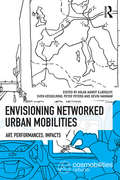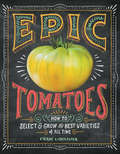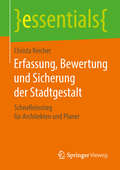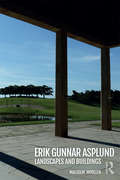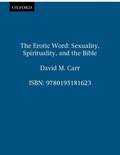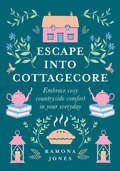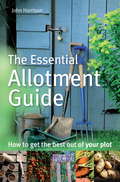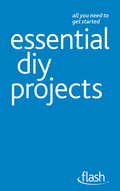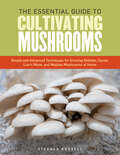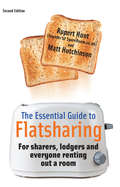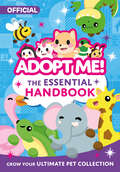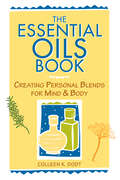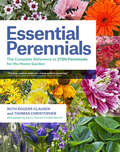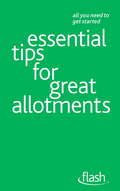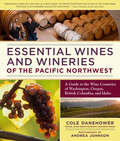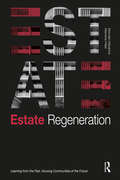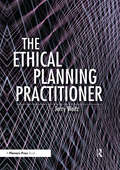- Table View
- List View
Envisioning Networked Urban Mobilities: Art, Performances, Impacts (Networked Urban Mobilities Series)
by Kevin Hannam Sven Kesselring Aslak Aamot Kjaerulff Peter PetersEnvisioning Networked Urban Mobilities brings together scientific reflections on the relations of art and urban mobilities and artistic research on the topic. The editors open the book by setting out the concept grounded in the exhibition curated by Aslak Aamot Kjærulff and refers to earlier work on mobilities and art generated by the Cosmobilities Network. This third volume has two sections, both consisting of short papers and illustrations. The first section is based on artists who were part of the conferences' art exhibition, and the second part is based on theoretical reflections on art and artists.
Envisioning Networked Urban Mobilities: Art, Performances, Impacts (Networked Urban Mobilities Series)
by Kevin Hannam Sven Kesselring Aslak Aamot Kjaerulff Peter PetersEnvisioning Networked Urban Mobilities brings together scientific reflections on the relations of art and urban mobilities and artistic research on the topic. The editors open the book by setting out the concept grounded in the exhibition curated by Aslak Aamot Kjærulff and refers to earlier work on mobilities and art generated by the Cosmobilities Network. This third volume has two sections, both consisting of short papers and illustrations. The first section is based on artists who were part of the conferences' art exhibition, and the second part is based on theoretical reflections on art and artists.
Epic Tomatoes: How to Select and Grow the Best Varieties of All Time
by Craig LeHoullierSavor your best tomato harvest ever! Craig LeHoullier provides everything a tomato enthusiast needs to know about growing more than 200 varieties of tomatoes, from planting to cultivating and collecting seeds at the end of the season. He also offers a comprehensive guide to various pests and tomato diseases, explaining how best to avoid them. With beautiful photographs and intriguing tomato profiles throughout, Epic Tomatoes celebrates one of the most versatile and delicious crops in your garden.
Epiphytic bromeliad (large print)
by RnibThis image shows an Epiphytic bromeliad growing on the branch of a tree. This is the Aechmea cylindrata variety, which can grow up to 50 centimetres high.There is a locator dot shown, which will be at the top left of the page when the image is the correct way up.You will find a tree branch going across the bottom of the page. Halfway along, the roots of the bromeliad are wrapped around it.Up from here are the plans long, pointed, green leaves growing up and out to the left and right. The plant stores the water that gathers in the overlapping leaf-base. At the top centre of the image is the bromeliads flower spike. It has individual flowers growing out to the left and right from a central stem. The flowers are magenta near the stem and pale blue at their tips. Bromeliads are native to South America. They include Pineapples and Spanish moss.
Epiphytic bromeliad (UEB contracted)
by RnibThis image shows an Epiphytic bromeliad growing on the branch of a tree. This is the Aechmea cylindrata variety, which can grow up to 50 centimetres high.There is a locator dot shown, which will be at the top left of the page when the image is the correct way up.You will find a tree branch going across the bottom of the page. Halfway along, the roots of the bromeliad are wrapped around it.Up from here are the plans long, pointed, green leaves growing up and out to the left and right. The plant stores the water that gathers in the overlapping leaf-base. At the top centre of the image is the bromeliads flower spike. It has individual flowers growing out to the left and right from a central stem. The flowers are magenta near the stem and pale blue at their tips.Bromeliads are native to South America. They include Pineapples and Spanish moss.
Epiphytic bromeliad (UEB uncontracted)
by RnibThis image shows an Epiphytic bromeliad growing on the branch of a tree. This is the Aechmea cylindrata variety, which can grow up to 50 centimetres high.There is a locator dot shown, which will be at the top left of the page when the image is the correct way up.You will find a tree branch going across the bottom of the page. Halfway along, the roots of the bromeliad are wrapped around it.Up from here are the plans long, pointed, green leaves growing up and out to the left and right. The plant stores the water that gathers in the overlapping leaf-base. At the top centre of the image is the bromeliads flower spike. It has individual flowers growing out to the left and right from a central stem. The flowers are magenta near the stem and pale blue at their tips.Bromeliads are native to South America. They include Pineapples and Spanish moss.
Erfassung, Bewertung und Sicherung der Stadtgestalt: Schnelleinstieg für Architekten und Planer (essentials)
by Christa ReicherChrista Reicher gibt einen Überblick über die Inhalte der Stadtgestalt und wie diese im planerischen Kontext im Sinne der Stadtgestaltung beeinflusst werden können. Neben einer Begriffsdefinition werden die unterschiedlichen Dimensionen der Stadtgestalt anschaulich beschrieben. In den vergangenen Jahrzehnten haben sich verschiedene Städtebauer und Stadtforscher mit der Stadtgestalt auseinandergesetzt. Hierzu werden die wichtigsten Theorien vorgestellt sowie ein Einblick in Methoden zur Erfassung und Bewertung der Stadtgestalt gewährt.Die Autorin Christa Reicher ist seit 2002 Professorin und Leiterin des Fachgebiets Städtebau, Stadtgestaltung und Bauleitplanung an der Fakultät Raumplanung der Technischen Universität Dortmund und ist Gründerin eines Planungsbüros mit Sitz in Aachen.
Erik Gunnar Asplund: Landscapes and Buildings
by Malcolm WoollenTaking an interdisciplinary approach, weaving together art, philosophy, history, and literature, this book investigates the landscapes and buildings of Swedish architect Erik Gunnar Asplund. Through critical essays and beautiful illustrations focusing on four projects, the Woodland Cemetery, the Stockholm Public Library, the Stockholm Exhibition and Asplund’s own house at Stennäs, it addresses the topic of buildings accompanied by landscapes. It proposes that themes related to landscape are central to Asplund’s distinctive work, with these particular sites forming a collection that documents an evolution in his design thinking from 1915 to 1940. The architect himself wrote comparatively little about his design intentions. However, through close reading and analysis of the selected projects as landscapes with architecture, author Malcolm Woollen argues that reflections of the history of Swedish landscape architecture and the intellectual climate in the late nineteenth and early twentieth centuries are evident in his work and help to explain the architect’s intentions. This book is a must-have for academics, advanced students and researchers in landscape architecture and design who are interested in Nordic Classicism and the works of Erik Gunnar Asplund.
Erik Gunnar Asplund: Landscapes and Buildings
by Malcolm WoollenTaking an interdisciplinary approach, weaving together art, philosophy, history, and literature, this book investigates the landscapes and buildings of Swedish architect Erik Gunnar Asplund. Through critical essays and beautiful illustrations focusing on four projects, the Woodland Cemetery, the Stockholm Public Library, the Stockholm Exhibition and Asplund’s own house at Stennäs, it addresses the topic of buildings accompanied by landscapes. It proposes that themes related to landscape are central to Asplund’s distinctive work, with these particular sites forming a collection that documents an evolution in his design thinking from 1915 to 1940. The architect himself wrote comparatively little about his design intentions. However, through close reading and analysis of the selected projects as landscapes with architecture, author Malcolm Woollen argues that reflections of the history of Swedish landscape architecture and the intellectual climate in the late nineteenth and early twentieth centuries are evident in his work and help to explain the architect’s intentions. This book is a must-have for academics, advanced students and researchers in landscape architecture and design who are interested in Nordic Classicism and the works of Erik Gunnar Asplund.
The Erotic Word: Sexuality, Spirituality, And The Bible
by David M. CarrHistorically, the Bible has been used to drive a wedge between the spirit and the body. In this provocative book, David Carr argues that it can--and should--do just the opposite. Sexuality and spirituality, Carr contends, are intricately interwoven: when one is improverished, the other is warped. As a result, the journey toward God and the life-long engagement with our own sexual embodiment are inseparable. Humans, the Bible tells us, both male and female, were created in God's image, and eros--a fundamental longing for connection that finds abstract good in the pleasure we derive from the stimulation of the senses--is a central component of that image. The Bible, particularly the Hebrew Bible, affirms erotic passion, both eros between humans and eros between God and humans. In a sweeping examination of the sexual rules of the Bible, Carr asserts that Biblical "family values" are a far cry from anything promoted as such in contemporary politics. He concludes that passionate love--our preoccupaton therewith and pursuit thereof--is the primary human vocation, that eros is in fact the flavoring of life.
Escape Into Cottagecore: Embrace Cosy Countryside Comfort In Your Everyday
by Ramona JonesFind happiness in the natural world, be fully present where you are and free yourself from the expectations of others.
The Essential Allotment Guide: How to Get the Best out of Your Plot
by John HarrisonIn recent years allotments have grown in popularity with demand far outstripping supply. John Harrison shows how to improve your chances of getting an allotment and move up the waiting list. In this all-encompassing guide, he also advises on clearing an allotment, planning what to grow and how, building compost bins, using raised beds - plus detailed instructions on growing the best vegetables and fruit.Praise for John Harrison's Vegetable Growing Month by Month:"...solid words of advice, written in a way that everyone will understand."Medwyn Williams, Chairman of the National Vegetable Society and member of the Fruit and Vegetable Committee of the Royal Horticultural Society.
Essential DIY Projects: Flash (Flash)
by DIY DoctorThe books in this bite-sized new series contain no complicated techniques or tricky materials, making them ideal for the busy, the time-pressured or the merely curious. Essential DIY Projects is a short, simple and to-the-point guide to that will teach you a number of essential projects around the house in just 96 pages. Suitable even for those who've never picked up a hammer, this is an ideal starting point for the new home-owner or tentative DIY-er.
The Essential Guide to Cultivating Mushrooms: Simple and Advanced Techniques for Growing Shiitake, Oyster, Lion's Mane, and Maitake Mushrooms at Home
by Stephen RussellWith clear instructions and step-by-step photographs, this straightforward guide shows you how to cultivate mushrooms in your own home.
The Essential Guide To Flatsharing, 2nd Edition: For sharers, lodgers and everyone renting out a room
by Matt Hutchinson Rupert HuntWhether you're looking for a flatshare or renting out a room The Essential Guide to Flatsharing has everything you need to know. If you're: * Renting out a spare room. * All about taking in a lodger; drawing contracts; the tax and financial issues; necessary preparation; advertising your room; and much more. * Looking for a flatshare. * Where to look; how to pick the best flatmates; how to keep your flatshare harmonious; how to avoid conflicts. * Finding a new flatmate. *How to advertise; picking the right person; dealing with money.
The Essential Handbook (Adopt Me!)
by Uplift GamesAn essential game companion for new players and long-time fans of the popular online game, Adopt Me!
The Essential Oils Book: Creating Personal Blends for Mind & Body
by Colleen K. DodtDiscover the fragrant world of essential oils. Herbalist Colleen K. Dodt profiles the healing and cleaning powers of dozens of oils extracted from herbs, flowers, roots, barks, and resins. This comprehensive guide includes recipes for natural cleaning products, lotions, and ointments that will keep you feeling happy and smelling great. Fill your days with stimulating scents as you learn to use essential oils to wash your dishes, soothe sunburns, combat stress, and improve the quality of your life.
Essential Perennials: The Complete Reference to 2700 Perennials for the Home Garden
by Ruth Rogers Clausen Thomas ChristopherPerennials—herbaceous plants that go dormant in the fall and then return in the spring—are the main fabric of any ornamental garden. With Essential Perennials, gardeners of all levels can cultivate a home garden lush with enduring colors, rhythms, and forms.
Essential Tips for Great Allotments: All You Need To Get Started (Flash)
by Geoff StokesThe books in this bite-sized new series contain no complicated techniques or tricky materials, making them ideal for the busy, the time-pressured or the merely curious. Essential Tips for Great Allotments: Flash is a short, simple and to-the-point guide that will teach you all the fundamentals for your allotment, from what tools to use to which crops to grow in just 96 pages. For those new to allotments, this is an ideal starting point for growing your own produce organically.
Essential Wines and Wineries of the Pacific Northwest: A Guide to the Wine Countries of Washington, Oregon, British Columbia, and Idaho
by Cole DanehowerSuperbly balanced pinot noirs; crisp rieslings; rich, heady syrahs: these are only a fraction of the expertly crafted wines being produced in the Pacific Northwest's diverse and distinctive wine countries. Second only to California in production, the Pacific Northwest is the largest wine region in North America, home to more than 1,000 wineries. What was once a young wine-growing area with a reputation for eccentricity is today recognized as a dynamic region producing world-class wines, with a focus on ecologically sound practices.This definitive volume profiles the wines, the people who make them, and the wine countries of Washington, Oregon, British Columbia, and Idaho. The journey begins with the region's climates and geology, which create a fascinating tapestry of wine-growing areas. Next, the book focuses on the unique qualities of each wine region, with profiles of more than 160 representative wineries to visit. Included are legacy wineries that helped to build the region’s reputation, prestige wineries with a national presence, under-the-radar artisan wineries that embody the pioneering spirit of the Northwest, and promising new wineries. Each profile lists the winery's signature, premium, value, and estate wines.Beautifully illustrated with photographs and helpful maps, this in-depth guide is a milestone in the North American literature on wine. It will enable wine lovers everywhere to plan their touring, select their wines, and explore and discover the riches of the Northwest's wine country.
Estate Regeneration: Learning from the Past, Housing Communities of the Future
by Brendan Kilpatrick Manisha PatelOne hundred years ago, the Addison Act created the circumstances for the large scale construction of municipal housing in the UK. This would lead to the most prolific phases of housing estate building the country has ever seen. The legacy of this historic period has been tackled for the last twenty-five years as these estates began to suffer from misguided allocation policies, systemic building and fabric failure and financial austerity. A series of estate regeneration programmes sought to rectify the mistakes of the past. Estate Regeneration describes 24 of these regeneration schemes from across the UK and the design philosophy and resident engagement which formed each new community. A number of essays from a wide range of industry experts amplify the learning experience from some key estate regeneration initiatives and provide observations on the broader issues of this sector of the housing market. Regeneration is inevitable; it is a matter of the form which regeneration should take. The information presented here is a guide to an intuitive approach to estate regeneration which commences with the derivation of strong urban design principles and is guided by real community engagement. The experience presented seeks to learn from the mistakes of the past to create the best possible platform for regeneration of the housing estates of the future.
Estate Regeneration: Learning from the Past, Housing Communities of the Future
by Brendan Kilpatrick Manisha PatelOne hundred years ago, the Addison Act created the circumstances for the large scale construction of municipal housing in the UK. This would lead to the most prolific phases of housing estate building the country has ever seen. The legacy of this historic period has been tackled for the last twenty-five years as these estates began to suffer from misguided allocation policies, systemic building and fabric failure and financial austerity. A series of estate regeneration programmes sought to rectify the mistakes of the past. Estate Regeneration describes 24 of these regeneration schemes from across the UK and the design philosophy and resident engagement which formed each new community. A number of essays from a wide range of industry experts amplify the learning experience from some key estate regeneration initiatives and provide observations on the broader issues of this sector of the housing market. Regeneration is inevitable; it is a matter of the form which regeneration should take. The information presented here is a guide to an intuitive approach to estate regeneration which commences with the derivation of strong urban design principles and is guided by real community engagement. The experience presented seeks to learn from the mistakes of the past to create the best possible platform for regeneration of the housing estates of the future.
Ethical Planning Practitioner
by Jerry WeitzIf a local college gives a city planner tickets to a sold-out football game, is it wrong to take them – even if the planner pays? Should a planning consultant bid on a project that has a clearly unrealistic timeframe? Can a planning director moonlight for another agency? For practicing planners, potential ethics violations abound, and the eye of public scrutiny never blinks. Planners need a guide, and now they have it: the first guidebook based on the current revision of the AICP (American Institute of Certified Planners) Code of Ethics and Professional Conduct. The Ethical Planning Practitioner presents 76 scenarios, all real-life dilemmas based on the code's rules of conduct. Each scenario comes with tools to help planners explore the answers on their own, in a training session, or in a classroom. This vital handbook looks at everyday ethics the way planners need to see them, in black, white, and shades of gray – but most of all, clearly. It will not only instruct but inspire planners to strengthen the public's trust.
